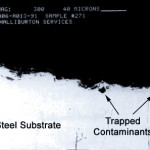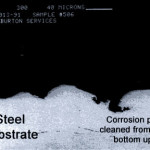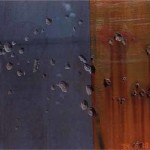 This method of surface preparation has been recognized by many of the technical societies that provide specifications to the painting industry. In 1995 SSPC and NACE issued the first joint written standard in the history of both organizations for UHP water jetting. NACE No. 5 and SSPC-SP12 were issued to give some consistency to inspection techniques. A NACE paper written in 1992 by Richard Dupuy, CEO of UHP Projects, Inc. was referenced in a footnote to this Standard. An interim visual standard was issued by SSPC and UHP Projects, Inc. was again acknowledged in this publication as having participated.
This method of surface preparation has been recognized by many of the technical societies that provide specifications to the painting industry. In 1995 SSPC and NACE issued the first joint written standard in the history of both organizations for UHP water jetting. NACE No. 5 and SSPC-SP12 were issued to give some consistency to inspection techniques. A NACE paper written in 1992 by Richard Dupuy, CEO of UHP Projects, Inc. was referenced in a footnote to this Standard. An interim visual standard was issued by SSPC and UHP Projects, Inc. was again acknowledged in this publication as having participated.
 Coatings manufacturers have also seen many benefits to this technology. Because these companies have recognized it as a valuable alternative that provides good coating life when properly used and matched with appropriate coatings they have issued their own standards. International Paint, Hempel, Jotun, and others have published standards for their products.
Coatings manufacturers have also seen many benefits to this technology. Because these companies have recognized it as a valuable alternative that provides good coating life when properly used and matched with appropriate coatings they have issued their own standards. International Paint, Hempel, Jotun, and others have published standards for their products.
This method of surface preparation will give a high cleanliness level as referenced in the above specifications. The visual appearance may be different because there is no deformation of the surface as occurs with abrasive blasting. The visual appearance will be a dark gray matte finish. See NACE/SSPC proposed specifications for UHP work.
 It is generally accepted that UHP technology does a better job of removing soluble contaminants than most abrasive systems. Ultra high pressure does not distort or abrade the metal surface and therefore does not give the white metal appearance. Also, UHP does not trap iron oxide or contaminants in the metal folds. Contamination in the metal folds has proven detrimental and can cause spot failures of the coatings that result in blistering. Support documents are available upon request.
It is generally accepted that UHP technology does a better job of removing soluble contaminants than most abrasive systems. Ultra high pressure does not distort or abrade the metal surface and therefore does not give the white metal appearance. Also, UHP does not trap iron oxide or contaminants in the metal folds. Contamination in the metal folds has proven detrimental and can cause spot failures of the coatings that result in blistering. Support documents are available upon request.




Follow Us!